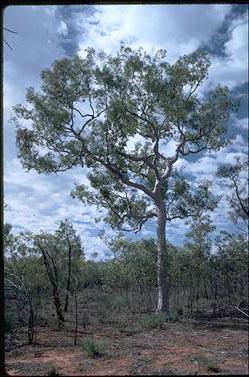Angophora costata
(Gaertn.) Hochr. ex Britten
Myrtaceae
Angophora lanceolata Cav.
Eucalyptus apocynifolia (Salisb.) Brooker
Melaleuca costata (Gaertn.) Raeusch.
Metrosideros apocynifolia Salisb.
Metrosideros costata Gaertn.
Metrosideros lanceolata Pers.
Common Name:
General Information
Angophora costata is an evergreen tree with an open, irregularly branched crown; it can grow 15 - 27 metres tall. The bole varies from short to long and straight, it can be 50 - 120cm in diameter[
].
The tree is sometimes harvested from the wild for its wood, which is used locally. The plant is sometimes grown as an ornamental[
].
Known Hazards
None known
Botanical References
365- Title
- Flora of New South Wales
- Publication
-
- Author
-
- Website
- http://plantnet.rbgsyd.nsw.gov.au/floraonline.htm
- Publisher
-
- Year
- 0
- ISBN
-
- Description
- An on-line resource giving a brief botanical description of all the native plants of New South Wales, their habitat and range, together with diagrams and photographs of the plants.
Range
Australia - Victoria, New South Wales, Queensland.
Habitat
Found on a wide range of topographical sites, from small flats on the sea coast to the ridges of mountains and on inland plains[
]. Deep sandy soils, or sandy soils on sandstone[
365- Title
- Flora of New South Wales
- Publication
-
- Author
-
- Website
- http://plantnet.rbgsyd.nsw.gov.au/floraonline.htm
- Publisher
-
- Year
- 0
- ISBN
-
- Description
- An on-line resource giving a brief botanical description of all the native plants of New South Wales, their habitat and range, together with diagrams and photographs of the plants.
].
Properties
| Medicinal Rating |      |
| Other Uses Rating |      |
| Habit | Tree |
| Height | 20.00 m |
| Pollinators | Bees, Insects |
| Cultivation Status | Ornamental, Wild |
Cultivation Details
A plant of mainly subtropical areas, just moving into the tropics in eastern Australia, where it is found at latitudes from 37 - 21°S[
]. It grows at elevations from sea level up to 300 metres[
]. It grows best in areas where annual daytime temperatures are within the range 18 - 28°c, but can tolerate 10 - 38°c[
]. Mature plants can be killed by temperatures of -5°c or lower, but new growth is badly damaged at 0°c[
]. It prefers a mean annual rainfall in the range 800 - 1,000mm, but tolerates 600 - 1,200mm[
].
Prefers a sunny position in a light to medium, well-drained soil[
]. Prefers a pH in the range 5.5 - 6.5, tolerating 5 - 7[
]. Established plants are drought tolerant[
].
Vigorous flowering only occurs once in every few years[
156- Title
- Useful Wild Plants in Australia.
- Publication
-
- Author
- Cribb. A. B. and J. W.
- Publisher
- William Collins Pty Ltd. Sidney
- Year
- 1981
- ISBN
- 0-00-216441-8
- Description
- A very readable book.
].
Edible Uses
None known
Medicinal
The resin from the trunk is astringent[
156- Title
- Useful Wild Plants in Australia.
- Publication
-
- Author
- Cribb. A. B. and J. W.
- Publisher
- William Collins Pty Ltd. Sidney
- Year
- 1981
- ISBN
- 0-00-216441-8
- Description
- A very readable book.
]. It is used in the treatment of diarrhoea[
1096- Title
- Native Tastes of Australia
- Publication
-
- Author
-
- Website
- http://tasteaustralia.biz/
- Publisher
-
- Year
- 0
- ISBN
-
- Description
- A website with detailed information on around 50 species of native Australian food plants, including recipes.
].
Agroforestry Uses:
The tree only flowers vigorously once every few years, but when it does it is an important source of pollen and yields a fairly pale honey of minor importance[
156- Title
- Useful Wild Plants in Australia.
- Publication
-
- Author
- Cribb. A. B. and J. W.
- Publisher
- William Collins Pty Ltd. Sidney
- Year
- 1981
- ISBN
- 0-00-216441-8
- Description
- A very readable book.
].
Other Uses
An astringent resin, known as kino, is obtained from the trunk[
156- Title
- Useful Wild Plants in Australia.
- Publication
-
- Author
- Cribb. A. B. and J. W.
- Publisher
- William Collins Pty Ltd. Sidney
- Year
- 1981
- ISBN
- 0-00-216441-8
- Description
- A very readable book.
].
The heartwood is a light pinkish-brown; the sapwood pale and up to 5 cm wide. The wood is moderately close-textured, with a rather interlocked grain, it is of moderate strength, very hard but not durable[
]. It is used for rough flooring, slabs, fence rails, palings and hardboard[
].
The wood is used for fuel[
].
Propagation
Seed - best sown as soon as it is ripe, though it can be stored. Sow in a fairly sunny position in a nursery seedbed. When large enough to handle, prick the seedlings out into individual pots and grow them on in a sunny position until large enough to plant out.
Cuttings of mature wood of the current seasons growth in sandy soil.
If you have any useful information about this plant, please leave a comment. Comments have to be approved before they are shown here.






 Useful Tropical Plants Database 2014 by
Ken Fern,
web interface by
Ajna Fern
with help from
Richard Morris.
Useful Tropical Plants Database 2014 by
Ken Fern,
web interface by
Ajna Fern
with help from
Richard Morris.